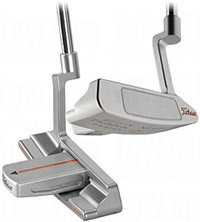 Scotty Cameron, in the mind of some, has been on a bit of a trip lately. As a long-time advocate of an absolutely anti-Pelzian “inside-square-inside” putting stroke, last year Scotty pushed his belief to the forefront with the odd-looking “Detour” putter. I reviewed the Detour favorably last December, and I still use it in a regular rotation with my Red X mallet.
Scotty Cameron, in the mind of some, has been on a bit of a trip lately. As a long-time advocate of an absolutely anti-Pelzian “inside-square-inside” putting stroke, last year Scotty pushed his belief to the forefront with the odd-looking “Detour” putter. I reviewed the Detour favorably last December, and I still use it in a regular rotation with my Red X mallet.
This year, Scotty has further pushed his belief that a good putting stroke moves in an arc by sticking a mini-Detour sight curve on the back of his rather classic Newport putters. Introduced in January as prototypes for market, the putters were released in late March.
Though I’ve always been more of a mallet guy myself, the Newports with the stuck-on sight curve look enough like mallets that I decided to give them a try. Read on to see whether the Newport Detours replaced my original Detour or took a detour of their own…
Design, Looks, and Setup
The Newport Detour putters are just what you would expect: part Newport, part Detour. A miniature version (about half the size) of the Detour’s sight curve has been bolted on to the back of two of Scotty’s Newport putters. The result: a heel-shafted, toe-hang blade putter with a built-in stroke and alignment aid.

Pretty standard fare for Cameron putters: 4° loft, 71° lie angle. I tested two 34″ putters.
Two Newport Detours exist: the Newport Detour 2 and the Newport Detour 2.5. The blades are the same, but the necks vary: the Newport 2 model features a plumber’s neck while the Newport 2.5 model employs a flowing neck.
Like the Detour, the Newport versions feature an aluminum sight curve which also doubles as the putter’s face (an illustration can be seen here). The face and curve are bolted to a stainless steel body shaped in the classic Newport style. With a little more weight in the toe and heel, the Newport Detours, unlike the original Detour, lack a toe weight, but retain the round 20 gram steel weight in the bottom, back portion of the sight curve for added stability and increased MOI.
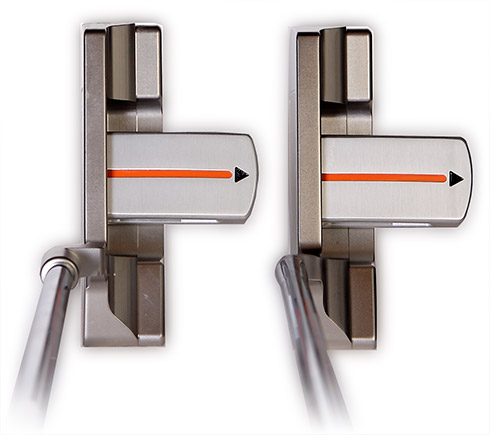
The look at address is surprisingly simple despite the arc sticking out of the back. Note the different necks.
The entire Detour line features an orange theme that carries into the ink fill on the Newport Detour stampings, with “SCOTTY” and “CAMERON” stamped on the back of the putter and “Scotty Cameron Design” and “Newport 2.5 Detour” stamped on the bottom in grey and orange. Even the grip is “Detour orange” and really stands out in a crowd of black putter grips (or, frankly, any other color).
Inside-Square-Inside
Scotty Cameron, like his pal Stan Utley and virtually every good putter I’ve ever seen, believe strongly that a good putting stroke travels inside the line on the back-stroke, squares up at impact, and goes inside again on the through-stroke, much like this:

The only way to putt? Scotty Cameron believes it’s the best way, that’s for sure. Forget Dave Pelz, man!
If you’re a Dave Pelz kind of guy, with a straight-back, straight-through stroke, then the Newport Detours just aren’t for you. Then again, if you’re putting badly with your Pelz stroke, the Newport Detours (or the Detour itself) may make for a fine training aid – if not your new gamer – in conditioning you to stroke the putter on a proper arc.
Like most Cameron putters, the Newport Detours have two characteristics that help arc-stroke putters: toe flow (or toe hang) and a shaft towards the heel (Scotty is quick to point out that true “heel-shafted” putters, like the Wilson 8802, are quite different than the heel biased putters he creates). Both the toe hang and the heel-ish shaft aid players in releasing the putter head through impact.
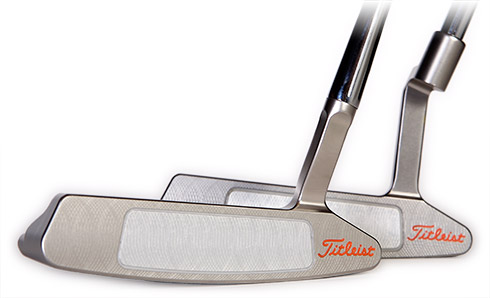
The faces you see here (again, note the necks) are part of the arc and are, thus, aluminum. I miss GSS.
Performance
Essentially, the Newport Detours are high-MOI Newports with a built-in alignment aid. Though I’ve never been a big fan of blade putters, preferring instead the Red X, Futura Phantom, and other mallet-style putters (including the oversized original Detour), the addition of the Detour sight curve to the back of a Newport allowed me to convince myself that I was playing a mallet. You may wish to think of the Newport Detours in the same way we see crossover vehicles these days – part car, part SUV. The advantage? The Newport Detours appeal to both blade and mallet fans, and with all the added benefits of increased stability and the built-in training aid.
How did the putters perform?
Admirably. I tested a 34″ version of both models, though my preferred length is 33″. I simply gripped down an inch most of the time, using the extra inch only on really long putts.
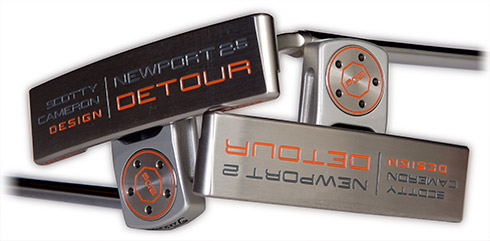
The 20 gram tungsten weight is visible here. Unlike the Detour itself, the sight curve isn’t fully hollowed out, though it is just behind the putter face. This hollow area may contribute to the higher-pitched sound these putters offer.
Initially, I had a little trouble aligning both putters. The sight curve – the painted orange arc – curves subtly and immediately from the back of the putter face. With the original Detour, I found it a little easier to ignore the line and use the putter’s face to align the putter to the ball. The Detour’s arc was an obvious curve, making it easier to ignore. The Newport Detour’s curve is a little more subtle, and at first, I found myself hitting putts left as I used the curve to align the putters to the ball rather than the edge of the face. The mallets I’ve used – a Red X and a Ray Cook M1-X before it – have alignment lines to which I’ve grown accustomed, so someone used to lining up to the ball with the perpendicular putter face will likely not share my early frustration.
Once I began aligning myself to the ball squarely, I was able to concentrate on other aspects of putting: feel, sound, balance, etc. With both the 2 and the 2.5, sound and feel at impact was crisp and solid. I’d characterize the sound as a bit higher pitched than I’d like, largely due to the aluminum face. My Red X has a soft GSS (German stainless steel) insert that mutes the sound nicely. Between the two, the plumber’s neck 2 model sounded at a higher frequency. I can only attribute that to the shape of the neck – it felt as if it vibrated a bit more than the thicker flowing neck on the 2.5 model. Quite honestly, I didn’t like the sound and never quite adjusted – I prefer the slightly softer GSS sound, or even the heavier sound of the original Detour.
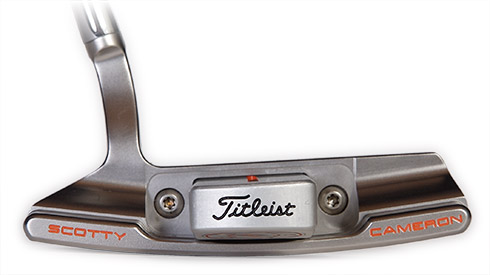
The face/sight curve is literally bolted on to a steel chassis on the Newport Detours (2.5 seen here).
The sound did offer some clues about mis-hit putts that I appreciated. Putts struck towards the toe or heel offered distinctly different tones than purely struck putts that better players will appreciate. Forgiveness on off-center hits was high, though not phenomenal – these aren’t the Futura, after all. Players can’t get away with poor contact, but mediocre contact is not punished harshly and on shorter putts, the ball will still find the hole.
As with all Scotty Cameron putters, distance perception was spot on. I found these putters easy to gauge on any length putt and on greens rolling at a variety of speeds. Though sound is a good portion of feel, the ball is long gone before your body processes what your ears hear. Despite the aluminum face – of which I’m really not a fan given today’s firm golf ball – distance control was not a problem. The putters are well balanced and swing easily, with just enough toe flow (about 40° toe hang on the 2, 45° on the 2.5) to aid but not overdo the putter head’s release.
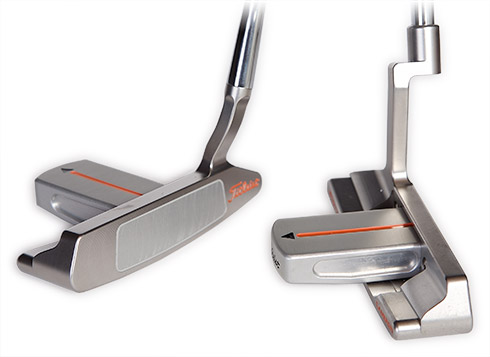
A better view of the two neck styles, with the 2.5 flowing neck left and the 2 plumber’s neck on the right.
I made a lot of putts with the Newport Detours. In the end, due to the slightly lower-pitched sound, I preferred the 2.5 over the Newport 2, though golfers – and certainly Cameron fanatics – will have their own choice based more on esthetic reasons than tiny differences in sound.
Specs
The Newport Detour 2 and 2.5 come with 4° loft and a lie angle of 71° standard. An orange Baby T grip and an orange headcover are standard. Both models feature a full shaft of offset.
The Newport Detour 2 is available in 33″ (350g, C6-C8), 34″ (340g, D0-D2), and 35″ (330g, D4-D6) versions for righties and 35″ for lefties. A custom-order 34″ length is available for lefties. The Newport Detour 2.5 is available for righties only in 34″ (340g, D0-D2) and 35″ (330g, D4-D6) lengths with a custom option for a 33″ (350g, C6-C8) version. Both are also available with custom-order Red Baby T or Red or Black Studio Design grips.
The retail price for both putters is $299 and both can be purchased at Edwin Watts.
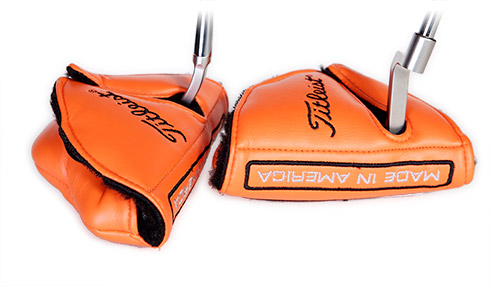
The Newport Detour headcovers are miniature versions of the Detour headcovers. They fit snugly and take up less room in your bag than you might think.
Conclusion
I’ve got to admire Scotty Cameron’s convictions: he believes you should putt on an arc, and he’s putting his putters where his mouth is, so to speak. The Newport Detours bring the “built-in training aid” found on the original Detour to the more traditional, more classic, an wildly popular Newport line.
These putters are a little unconventional, though putter convention these days is to be unconventional. Aside from a higher pitched sound than I’d prefer, these putters are solid performers that smoothly blend what could have been an eyesore in the sight curve with the classic lines of the Newport. These putters will help you make more putts, and will keep your stroke in good shape while doing it.

Nice review, Erik. Even though I have always putted better with the Pelz method and face balanced putters, when I tried the big mallet Detour last year I thought it was a very nice feeling putter and produced great results.
While I believe that the “arc v. straight line” putting debate is, like many golf “method” debates, sort of like arguing about the number of angels dancing on the head of a pin, I like to point out to “screen door” guys that Pelz proves his point pretty well in his books, with some very good photography. What I’m trying to say is that if you are a guy who wants to putt straight back and through, don’t believe some of the “screen door” guys who tell you it’s not “possible” or not “natural.” Either style is perfectly natural, it just comes down to what you like to do.
I don’t want this to turn into a debate on putting methods, but Scotty Cameron could argue with some pretty logical math and physics. He too has a pretty high-tech putter studio of his own, complete with cameras and sensors to monitor everything. And, lest I point out, even Dave Pelz’ primary student putts with an arc stroke.
Regardless of the method you use, it’s still important to choose a putter that suits that method. Virtually every Scotty Cameron is intended to be used with an arc stroke – especially the Detours and Newport Detours.
There’s further discussion of this, including some information from Scotty Cameron, here and elsewhere on the Web, including scottycameron.com.
Right–it can be a tedious debate.
The thing I object to is not really the question of which method might be better, but the position, on either side, that the opposite method is some how “impossible.” I think you hear Utley/Cameron people saying that the Pelz stroke is “impossible” more than the obverse.
It’s not impossible to use a Pelzian “PILS” putting stroke for most stroke lengths.
Nice looking putter, but I am of the straight back,and through mob. I prefer a mallet type as well. So this putter is not for me. I still love my three ball 😎
Good review. I went to the pro shop yesterday intending to buy an Odyssey 2 Ball SRT with the XG face, having putted with a center-shafted Ping G5i blade for around 3 years. As usual I got sidetracked by the Scotties, and was particularly interested in the Newport detour 2 – I like the look, really compact and neat, and the feel was good, although I prefer the GSS/urethane insert on the regular Newports. I didn’t buy anything, preferring to take some time to think and get some info on the putters. I kind of wish Scotty would swallow his pride and produce an optional Newport style putter with the backweight and a straight sightline, coz I think it would make an excellent alignment aid on a refined looking putter. I’ll go back tomorrow and probably pick up the Newport Detour 2, if not the Newport 2!
It is a fine review, kind of a tricky putting issue, straight back and through or “arc” line and through. All I can say is, I bought the Detour (original) and at first the curved line bothered me, but putting on the practice green I was nailing everything. I use the “claw” grip and so I tended to be straight back and through, and on short putts this style of grip is money. At first with the Detour I noticed that I did pull the short ones left, probably because I was paying to much attention to the back line. I abandoned that and just paid attention to “my target mark” and I started drilling the short ones as well. To make a long story short, we had a pro-am at my club and I had the best putting day of my golf career (43 yrs.) shot a 33 on the back nine with 5 one putt birdies in the round. I had a 74 to our pros 75 and I had an 8 on one par 5. I had never done anything even remotely close to that before in a tournament, though I have had a few really good putting days. Anyway I am kind of sad that I don’t see this putter in the hands of a competent pro on television, even all those seniors now using the claw would benefit from this alignment marvel. What I don’t like about it is the Huge head cover which looks like someones ugly christmas slipper covering the other clubs in the bag. I shucked the cover, got a few bag dings on the Detour (blashphemy), but the putter seems to work fine regardless. I’ve had other Scotty putters and they worked, but not like this one, there was some pretty sneaky thinking going into the development of this putter. Many people buy Scotty’s for investments (resale on ebay) like a dress watch they never use. This is a Scotty for playing golf with. I like it.
I think that this newport detour putter is a good one but, there is no comparison to the studio style newport. It is almost the same thing and is less to look at. Some people like that there is less to look at and some like more, I just think less is better.
The feel of a blade putter and the alignment of a mallet putter is great. This putter Newport Detour 2 has improved my putting dramatically .My golf buddies cannot believe the difference in my putting.It is now very rare that I miss my line.
This is the very best putter I have ever used.
Brian
Wonderful review.
This putter becomes a gift to myself after breaking 90; however in the game next day I bought this putter, I always miss RIGHT. It’s totally different result with comments, even erik’s review. I found the reason is CG on putter face, wasn’t the line of orange alightment arow, but a little bit closer to heel ( camron website’s video for this putter mention by himself as well ). So every puts I aim and hit arow, club twist to clockwise direction, then I miss right.
Everyone here who have this putter can try to find less vibration hitting point on club face by using golf ball to bounce on face with 2 inch high. Now I start aiming toward lower edge of that aluminum sight block, and having much solid feeling, and the feelings I like.
I was using a face balanced(plumbing) anser putter, knows this solid feeling can feel only when hitting the center of putter head ( the extend line of shaft’s axis cross the club face ). This is the 1st time I use putter with “toe flow”, so now I have the confusion is….
People using putter with toe flow, feels solid hit, cause amount of toe flow just helps releasing the club head, so off center hit ( in this case the aluminum sight is off center ) feels less unsolid ( or solid if you prefer ), or friends here same just aiming little closer to heel like me now? 😳
I love this great looking putter, but if I can’t solve this puzzle, to find the right spot to hit on the club face, I will keep looking another putter.. 😥
Ever since I have had this putter, no more 3 putts!!!
What a fantastic review! I have been playing my Detour Newport 2 for 50+ rounds now and there are a great many things that Erik points out as being true, based on my experiences. As with the past comments related to the introduction of these putters, they are not just a “training aid”, but rather are legitimate putters. As with others, I will not get into the physics or mechanics of the putting stroke, as I am of firm belief that much like anything in golf; to each their own. What I do know is that the Detour suits my style of putting perfectly. I have had many look at my putting stroke and comment how I am not a straight back and straight forward putter, but rather I am an inside to inside putter, and that is wrong according to them. For this, I have been called a “lazy” putter because I do not want to work to keep the club straight througout the stroke. My belief has never changed; why should I? The Detour plays very well to my stroke, which I consider natural, and I suppose I can’t ask for anything else as a golfer. Since you logically expend close to a third of your strokes on the putting green, would one not think it best to find a club that can minimize your strokes in this area?
As for the looks of this putter? It is what it is, nothing ugly and nothing gorgeous. I find it no more unattractive than a three-ball putter and in fact, find it more attractive because it combines the aesthetics of a blade putter and a less bulkier mallet putter. How can that be considered ugly? As for the head cover…You certainly won’t be leaving it on the green as it really stands out. Sure, it may not be appealing to some, but if this is the worst thing about the Detour, then there really are no problems. The Detour is a solid putter with performance built into it. It may not be for everyone, but it is for me…And that really is all that matters, in my opinion.
Great review, as usual, and very helpful for those that may be interested in making this investment.